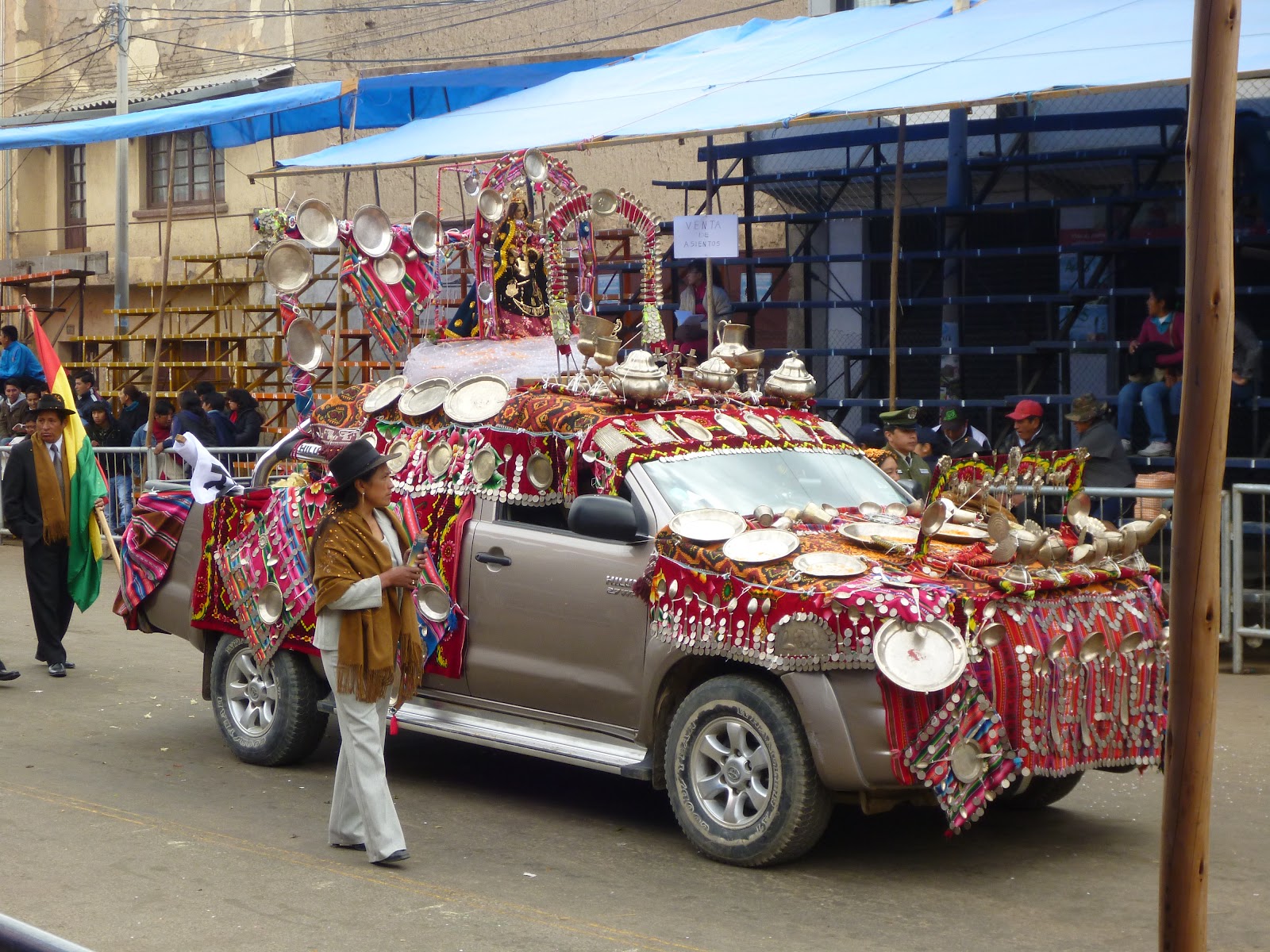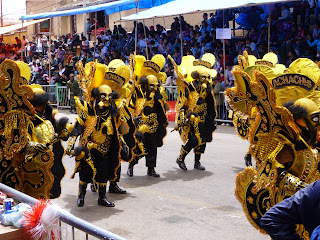Today, I spent the entire day watching the Oruro carnival parade, a Unesco oral and intangible world heritage. I turned up at my seat around 7 am, only to find out that - in typical South American fashion - 7 am doesn't mean 7 am sharp. Around 8, the parade finally started to arrive at my seat.
The entire parade was accompanied by police who, especially later in the day, had a lot to do trying to keep the street clear for the parade.
The program for the day listed 48 participating groups, and the parade was scheduled to last until after midnight. I didn't stay that long, however - I left around 9 pm because it was too damn cold ;-)
Within each of the groups, there was basically the same order. First came a decorated car featuring an image of the virgin of Socavón. The silverware on the car symbolizes the mineral wealth of Oruro.
After the car came a pattern that was repeated several times depending on the size of the group: bunch of costumed dancers - band - another bunch of costumed dancers.
The bands consisted mainly of drums and brass; only a few groups had other instruments like flutes. But each group had their own songs, and many people in the audience sang along.

But, without any doubt, the main attraction were the dancers and their amazing costumes.
All the different groups, costumes and songs have a background in Bolivian history and customs.
The Diablada, for example, is a group of devils who are commanded by an angel.
This symbolizes the virgin of Socavón protecting the miners from the evils that lurk in the mines.
Look at the amount of detail and colors in these masks:

Bears like these were accompanying every diablada group, but I couldn't find out what exactly they stand for. The people loved them, and cheered "osos, osos" every time they appeared.
Just to give you an impression of how many people were participating:

At night, one of the groups added lights to their costumes. They also had some fireworks coming from their masks, but I didn't manage to take a picture of that ;-)

The Morenada symbolize Spanish colonization and the enslavement of the native population.
Each of these costumes weighs about 65 kg, the masks alone about 20.
The Llamerada stand for all the llama-raising peasants in Bolivia. Note how every dancer holds a small toy llama :-)

The dance of the Caporales originates in the dance of the slaves the Spanish brought from Africa.

The Incas represent the inca (of course) and how they dealt with the Spanish conquest.

The Tobas represent the first inhabitants who hunted in the Bolivian rainforest. They had some really huge feathery costumes:

The bulk of them was dressed a little more simply though:

These are two more of the really big costumes:

Finally, the Suri Sicuri had huge round feather headdresses:

To support the spectators throughout the entire Entrada, there were tons of vendors selling their wares directly at the seats: ice cream, soft drinks, sweets, potato chips, salchipapas (fries with sausages), charquekán (a meal consisting of llama meat, boiled egg, corn and cheese), and, of course, lots of beer. If it weren't for the need to go to the toilet, you wouldn't have to get up all day ;-)
The entire parade was accompanied by police who, especially later in the day, had a lot to do trying to keep the street clear for the parade.
The program for the day listed 48 participating groups, and the parade was scheduled to last until after midnight. I didn't stay that long, however - I left around 9 pm because it was too damn cold ;-)
Within each of the groups, there was basically the same order. First came a decorated car featuring an image of the virgin of Socavón. The silverware on the car symbolizes the mineral wealth of Oruro.
After the car came a pattern that was repeated several times depending on the size of the group: bunch of costumed dancers - band - another bunch of costumed dancers.
The bands consisted mainly of drums and brass; only a few groups had other instruments like flutes. But each group had their own songs, and many people in the audience sang along.

But, without any doubt, the main attraction were the dancers and their amazing costumes.
All the different groups, costumes and songs have a background in Bolivian history and customs.
The Diablada, for example, is a group of devils who are commanded by an angel.
This symbolizes the virgin of Socavón protecting the miners from the evils that lurk in the mines.
Look at the amount of detail and colors in these masks:

Bears like these were accompanying every diablada group, but I couldn't find out what exactly they stand for. The people loved them, and cheered "osos, osos" every time they appeared.
Just to give you an impression of how many people were participating:

At night, one of the groups added lights to their costumes. They also had some fireworks coming from their masks, but I didn't manage to take a picture of that ;-)

The Morenada symbolize Spanish colonization and the enslavement of the native population.
Each of these costumes weighs about 65 kg, the masks alone about 20.
The Llamerada stand for all the llama-raising peasants in Bolivia. Note how every dancer holds a small toy llama :-)

The dance of the Caporales originates in the dance of the slaves the Spanish brought from Africa.

The Incas represent the inca (of course) and how they dealt with the Spanish conquest.

The Tobas represent the first inhabitants who hunted in the Bolivian rainforest. They had some really huge feathery costumes:

The bulk of them was dressed a little more simply though:

These are two more of the really big costumes:

Finally, the Suri Sicuri had huge round feather headdresses:

To support the spectators throughout the entire Entrada, there were tons of vendors selling their wares directly at the seats: ice cream, soft drinks, sweets, potato chips, salchipapas (fries with sausages), charquekán (a meal consisting of llama meat, boiled egg, corn and cheese), and, of course, lots of beer. If it weren't for the need to go to the toilet, you wouldn't have to get up all day ;-)








